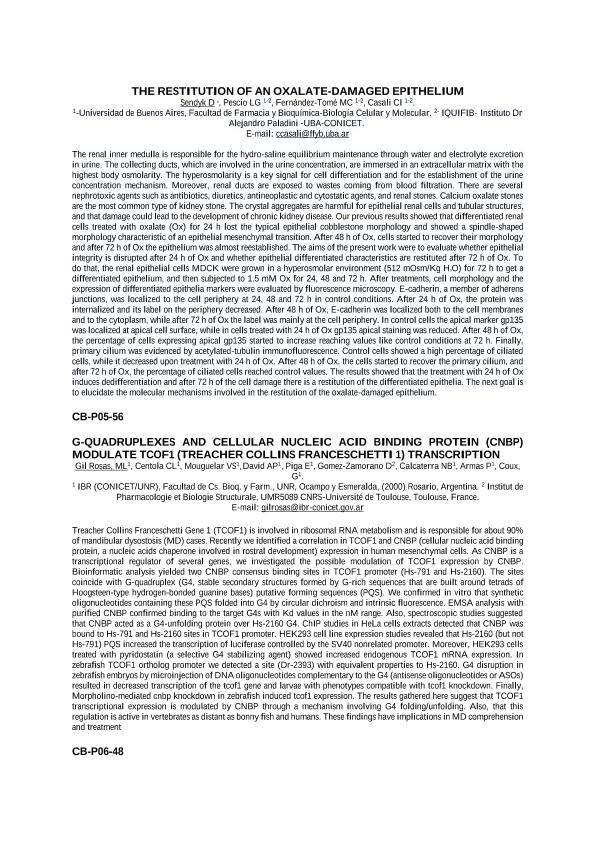Mostrar el registro sencillo del ítem
dc.contributor.author
Sendyk, Dylan
dc.contributor.author
Pescio, Lucila Gisele

dc.contributor.author
Fernández Tomé, M. C.
dc.contributor.author
Casali, Cecilia Irene

dc.date.available
2022-10-14T10:59:37Z
dc.date.issued
2021
dc.identifier.citation
The restitution of an oxalate-damaged epithelium; LVII Annual Meeting of the Argentine Society for Biochemistry and Molecular Biology Research and XVI Annual Meeting of the Argentinean Society for General Microbiology; Virtual; Argentina; 2021; 71-71
dc.identifier.issn
1667-5746
dc.identifier.uri
http://hdl.handle.net/11336/173137
dc.description.abstract
The renal inner medulla is responsible for the hydro-saline equilibrium maintenance through water and electrolyte excretionin urine. The collecting ducts, which are involved in the urine concentration, are immersed in an extracellular matrix with thehighest body osmolarity. The hyperosmolarity is a key signal for cell differentiation and for the establishment of the urineconcentration mechanism. Moreover, renal ducts are exposed to wastes coming from blood filtration. There are severalnephrotoxic agents such as antibiotics, diuretics, antineoplastic and cytostatic agents, and renal stones. Calcium oxalate stonesare the most common type of kidney stone. The crystal aggregates are harmful for epithelial renal cells and tubular structures,and that damage could lead to the development of chronic kidney disease. Our previous results showed that differentiated renalcells treated with oxalate (Ox) for 24 h lost the typical epithelial cobblestone morphology and showed a spindle-shapedmorphology characteristic of an epithelial mesenchymal transition. After 48 h of Ox, cells started to recover their morphologyand after 72 h of Ox the epithelium was almost reestablished. The aims of the present work were to evaluate whether epithelialintegrity is disrupted after 24 h of Ox and whether epithelial differentiated characteristics are restituted after 72 h of Ox. Todo that, the renal epithelial cells MDCK were grown in a hyperosmolar environment (512 mOsm/Kg H2O) for 72 h to get adifferentiated epithelium, and then subjected to 1.5 mM Ox for 24, 48 and 72 h. After treatments, cell morphology and theexpression of differentiated epithelia markers were evaluated by fluorescence microscopy. E-cadherin, a member of adherensjunctions, was localized to the cell periphery at 24, 48 and 72 h in control conditions. After 24 h of Ox, the protein wasinternalized and its label on the periphery decreased. After 48 h of Ox, E-cadherin was localized both to the cell membranesand to the cytoplasm, while after 72 h of Ox the label was mainly at the cell periphery. In control cells the apical marker gp135was localized at apical cell surface, while in cells treated with 24 h of Ox gp135 apical staining was reduced. After 48 h of Ox,the percentage of cells expressing apical gp135 started to increase reaching values like control conditions at 72 h. Finally,primary cilium was evidenced by acetylated-tubulin immunofluorescence. Control cells showed a high percentage of ciliatedcells, while it decreased upon treatment with 24 h of Ox. After 48 h of Ox, the cells started to recover the primary cilium, andafter 72 h of Ox, the percentage of ciliated cells reached control values. The results showed that the treatment with 24 h of Oxinduces dedifferentiation and after 72 h of the cell damage there is a restitution of the differentiated epithelia. The next goal isto elucidate the molecular mechanisms involved in the restitution of the oxalate-damaged epithelium.
dc.format
application/pdf
dc.language.iso
eng
dc.publisher
Tech Science Press

dc.rights
info:eu-repo/semantics/openAccess
dc.rights.uri
https://creativecommons.org/licenses/by-nc-sa/2.5/ar/
dc.subject
EPITHELIAL RESTITUTION
dc.subject
OXALATE
dc.subject.classification
Bioquímica y Biología Molecular

dc.subject.classification
Ciencias Biológicas

dc.subject.classification
CIENCIAS NATURALES Y EXACTAS

dc.title
The restitution of an oxalate-damaged epithelium
dc.type
info:eu-repo/semantics/publishedVersion
dc.type
info:eu-repo/semantics/conferenceObject
dc.type
info:ar-repo/semantics/documento de conferencia
dc.date.updated
2022-09-22T11:44:14Z
dc.journal.pagination
71-71
dc.journal.pais
Argentina

dc.journal.ciudad
Mendoza
dc.description.fil
Fil: Sendyk, Dylan. Universidad de Buenos Aires. Facultad de Farmacia y Bioquímica. Departamento de Ciencias Biológicas. Cátedra de Biología Celular y Molecular; Argentina
dc.description.fil
Fil: Pescio, Lucila Gisele. Consejo Nacional de Investigaciones Científicas y Técnicas. Oficina de Coordinación Administrativa Houssay. Instituto de Química y Físico-Química Biológicas "Prof. Alejandro C. Paladini". Universidad de Buenos Aires. Facultad de Farmacia y Bioquímica. Instituto de Química y Físico-Química Biológicas; Argentina. Universidad de Buenos Aires. Facultad de Farmacia y Bioquímica. Departamento de Ciencias Biológicas. Cátedra de Biología Celular y Molecular; Argentina
dc.description.fil
Fil: Fernández Tomé, M. C.. Consejo Nacional de Investigaciones Científicas y Técnicas. Oficina de Coordinación Administrativa Houssay. Instituto de Química y Físico-Química Biológicas "Prof. Alejandro C. Paladini". Universidad de Buenos Aires. Facultad de Farmacia y Bioquímica. Instituto de Química y Físico-Química Biológicas; Argentina. Universidad de Buenos Aires. Facultad de Farmacia y Bioquímica. Departamento de Ciencias Biológicas. Cátedra de Biología Celular y Molecular; Argentina
dc.description.fil
Fil: Casali, Cecilia Irene. Universidad de Buenos Aires. Facultad de Farmacia y Bioquímica. Departamento de Ciencias Biológicas. Cátedra de Biología Celular y Molecular; Argentina. Consejo Nacional de Investigaciones Científicas y Técnicas. Oficina de Coordinación Administrativa Houssay. Instituto de Química y Físico-Química Biológicas "Prof. Alejandro C. Paladini". Universidad de Buenos Aires. Facultad de Farmacia y Bioquímica. Instituto de Química y Físico-Química Biológicas; Argentina
dc.relation.alternativeid
info:eu-repo/semantics/altIdentifier/url/https://congresos.g2consultora.com/wp-content/uploads/2021/10/Biocell-Preprint-SAIB-SAMIGE-2021.pdf
dc.conicet.rol
Autor

dc.conicet.rol
Autor

dc.conicet.rol
Autor

dc.conicet.rol
Autor

dc.coverage
Nacional
dc.type.subtype
Reunión
dc.description.nombreEvento
LVII Annual Meeting of the Argentine Society for Biochemistry and Molecular Biology Research and XVI Annual Meeting of the Argentinean Society for General Microbiology
dc.date.evento
2021-11
dc.description.ciudadEvento
Virtual
dc.description.paisEvento
Argentina

dc.type.publicacion
Journal
dc.description.institucionOrganizadora
Sociedad Argentina de Investigación Bioquímica y Biología Molecular
dc.description.institucionOrganizadora
Asociación Civil de Microbiología General
dc.source.revista
Biocell
dc.type
Reunión
Archivos asociados
